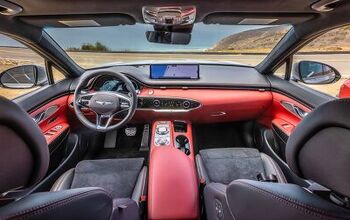2025 Polestar 3 First Drive Review: The Big Show

The 2025 Polestar 3 has me thinking about the McPizza.
No, it’s not because that ill-fated pie has secretly lived on here in Jackson Hole, Wyoming, where Polestar is hosting journos and industry analysts. America’s most wealthy ( and unequal) county is more about $200 shots of whiskey at the Million Dollar Cowboy Bar or multi-pound servings of bison tenderloin, anyway. (I only tried the latter, thanks.) It’s about the importance of knowing your audience.
With recent updates, the Polestar 2 is now a very good car. But it’s still a car in an SUV market; it’s almost academic if it’s a better pizza than what else is out there, because the people shopping modern luxury don’t want pizza.
The 3 is Polestar meeting the market where it is. The challenge? Standing out in one of the most crowded, talented segments in the automotive landscape.
2025 Polestar 3 Quick Take
The 2025 Polestar 3 proves the third time’s the charm for the young Swedish automaker. This upper-mid-sized all-electric SUV hits all the right notes for mainstream success, but isn’t without a few early teething issues.
What’s new for 2025:
Everything, basically. The Polestar 3 is the brand’s first SUV, it rides on new-to-the-brand platform, and it introduces myriad tech and safety features. This is a big vehicle, measuring 192.9 inches (4,900 millimeters) from tip to aero-optimized tail. It’s a hefty one too, a curb weight of up to 5,886 pounds (2,670 kilogram) making this a cool 1,000 pounds more than the 2. Yet a ground-up platform has its advantages: despite the height required for this class, the Polestar 3 boasts a lower center of gravity than the 1, the svelte (and fiendishly complex) coupe that launched the brand.
At launch, all Polestar 3s in North America will come with a 107-kilowatt-hour (usable) battery pack, supplying juice to a dual-motor setup. The standard setup is good for 489 horsepower and 620 pound-feet of torque; check the box for the Performance Pack and those numbers improve to 517 and 671, respectively. That’s enough to shave the five-second dash to 62 mph (100 km/h) down to 4.7 seconds. Range is up to 315 miles (506 km), though the Perf Pack’s added power and larger, 22-inch wheels knock that down to 279 mi (449 km).
Exterior style: Evolving the brand
After looking very much like Volvos with a strange new badge, Polestar’s design language is coming into its own with the 3 (and 4). The grille shape is still a familiar hexagon, but it’s now flanked by unique, arrow-shaped headlights. The profile is much more daring, with contrast trim running high up the doors and that dramatically tapering fastback roofline. Polestar has—like almost every other brand—committed to a full-width taillight setup here, but the lighting signature is flipped and squished compared to the Polestar 2. As is standard, there is no model badging or a spelled-out brand name, just the logo for a clean tailgate. While the standard rolling stock is a set of 20-inch alloys and 21s are available, the Long Range tester I experienced (light gray or “Magnesium”) rolls on upsized 22s. These are the same size but a different design from the Perf Pack setup (“Thunder”).
2025 Polestar 3: All the Details
Powertrain and fuel economy: Right on target
In the Performance Pack model this is, essentially, the same dual-motor setup found in the Volvo EX90 I recently drove, just with an additional seven ponies. It is of course effortlessly quick for all day-to-day activities, at least once it gets going. Polestar has made a concerted effort to avoid the jerkiness often inherent in modern EVs, but I’d argue the company has over-corrected. In the regular drive mode, there is a noticeable delay between stomping the pedal and the 3 near-silently surging forward. Sport mode does remedy this; not completely, but enough to better align with expectations. Polestar doesn’t do the whole manufactured acceleration sounds thing, so speed builds without notice. Keep an eye on that speedo.
I had started the day’s driving in the non-PP model. No FOMO here; the 28-horsepower advantage is basically imperceptible.
Efficiency, even as we wind our way around the Grand Tetons, seems at least on par with the official figures: 38.9 kWh per 100 miles for the base model, and 43.2 kWh per 100 miles for the Perf Pack. At full charge, the cars are showing more than the official range. Fast charging tops out at 250 kW, making for an optimum 10–80 percent recharge in 30 minutes.
Handling and drivability: Sportier side
It’s clear the Polestar 3 operates on the sportier side of the EV spectrum. Turn-in is quick and eager, and the big crossover responds well without the need for rear-wheel steer. There is little body roll from the twin-chamber air suspension, only enough to remind the driver of the significant forces in play here. Both models use a twin-clutch torque vectoring system on the rear axle, which can adjust the power left-to-right through corners to keep the vehicle on the intended line. Like the right font choice in a book, when it works it’s basically invisible, and those consistent responses contribute to driver confidence. Steering feedback is minimal, but there are three weighting settings for driver preference. Light is retiree-in-a-Buick spec, feeling too insubstantial for something this dense. The heaviest goes too far the other way, with good self-centering but artificial heft. Normal strikes an ideal balance. Drivers have three suspension setting choices, too: standard, nimble, and firm. Even the latter is acceptable on public roads, but true to its name, it’s the middle option that feels just right.
One pedal driving now has three settings, too: off, light, and on, the latter of which is still aggressive but toned down versus the same setting in the Polestar 2. Should you need more stopping power, the big Brembo brakes haul the not-insignificant mass down with a positive pedal feel and without fuss.
Ride quality and comfort: Opposing forces
Despite the clear sporting intentions, the Polestar 3 is pliant and accommodating when not hustling. The 22s transmit more noise than jostles to the cabin, which remains impressively hushed even well into highway speeds. Potholes and broken pavement are handled with aplomb, the 3 remaining poised throughout everything Wyoming throws at us. The earlier group in the week had to contend with surprise snow, which must have been… illuminating on summer performance rubber. But for us, with temps at typical levels and rain staying at bay for the day, the 3 swallows up the miles in a way that suggests excellent long-distance capability.
Interior style and quality: Scandinavian cool
There’s a pared-back design ethos here that only the Swedes can really pull off. A clean dashboard design hits the right premium design notes: tastefully sparse usage of brushed metals, a welcome application of knit material along key touchpoints, smooth Nappa leather nearly everywhere else. There’s even some info on the seats detailing the carbon footprint of the leather: yep, it’s still real former animal, but Polestar strives to make that as sustainable as possible. My only major ding is the considerable shiny black plastic on the center console.
Regardless of what they’re covered in, the seats are supportive and comfortable. This is mostly true out back as well: the swoopy roofline only dips Earth-bound behind the headrests, so even taller folks shouldn’t feel cramped. The rear cushions are mounted noticeably low however, so there’s less under-thigh support than I’d prefer in a luxury SUV.
One more catch: while the seat adjustments are clever minimalism, with a nudge-and-twist square in place of the usual controls, we experienced some lag with the system. The central button changes which part of the seat is adjustable, but the central screen would sometimes take seconds to switch.
Cargo space is impressive, including an available folding floor for access to a more secure cubby down low. The floor also features hooks when upright.
Tech and safety: Work in progress
Like the EX90, the 3 features a large 14.5-inch central touchscreen and a smaller, 9.0-inch column-mounted display behind the wheel. Both are super sharp, and the clean orange-and-white color scheme makes everything incredibly legible. Polestar has reworked its settings menus too, now with larger tiles that provide some visual cues about their respective settings. What’s more, while you can easily turn on and off settings from here, one poke of the illustration expands on the option, providing a brief description. This makes it super simple to get accustomed to the vehicle’s various settings.
There are still some hang-ups here however, as so many controls are tied to the screen. Detailed climate adjustments take up much of the screen. So does adjusting the seats. Should you want to make use of the seat massage function, it’s at least four taps: first the seat adjuster button, then the massage menu tab, then making any selections, then actually starting the whole thing. The massage programs are simply numbers on screen too, only explaining which one is which once selected. Adjusting the mirrors and wheel is as fiddly as expected, though it’s important to note owners will enjoy a set-it-and-forget-it experience here.
My other criticisms can be brought over wholesale from the Volvo. An adaptive cruise control system without gap distance adjustment is very basic for a car approaching six figures. The much-touted LiDAR satefy system won’t be fully operational until next year. The 360-degree camera is useful but oddly low-res. Our Long Range tester employed lane keep assist even though the setting was off; my co-driver and I cycled the feature and it worked as advertised after, but it was odd nonetheless. The card-as-key system proved finnicky and unreliable—what’s wrong with a classic on/off button for the vehicle?
No doubt about it: the 25-speaker Bowers & Wilkins audio system is excellent, filling the cabin with sound and showcasing distinct differences within its settings.
Value, dollars, and sense:
Polestar is pricing the 3 right in the thick of the segment. The Long Range Dual Motor starts at $74,800 ($95,900 CAD) including destination. Launch Editions throw in the $5,500 ($7,000 CAD) Plus pack, which adds the B&W system, acoustic glass, head-up display, soft-close doors, and more. The Performance Pack is a further $6,000 ($7,000 CAD) surcharge. The two US-spec testers I spent time in go for $88,100 (LRDM) and $93,100 (PP). All North American Polestar 3s will be built in the US.
Options as varied as the BMW iX, Audi Q8 e-tron, and Acura ZDX Type S all start at similar prices. Don’t forget the Cadillac Lyriq or the (admittedly smaller) Genesis Electrified GV70.
Final thoughts: 2025 Polestar 3 First Drive Review
As was the case with the Volvo EX90, the 2025 Polestar 3 has a few electronic niggles that can’t go ignored. The core experience is good however, as the brand is using the 3 to stake out its place on the more driver-focused end of the luxury SUV spectrum. Comfortable, well-trimmed, and with a more holistic approach to sustainability, all wrapped up in the shape the market demands, the Polestar 3 better aligns with North American tastes.
Become an AutoGuide insider. Get the latest from the automotive world first by subscribing to our newsletter here.
Pros | Cons |
|---|---|
Smooth power | Too many controls locked to touchscreen |
Adept handler | Waiting for features to come online |
Focus on sustainability | Second row seats too low |
2025 Polestar 3 | |
|---|---|
Motors: | 2 x electric motors |
Outputs: | 489 hp, 620 lb-ft (LRDM), 517 hp, 671 lb-ft (PP) |
Transmission: | 1AT, AWD |
US Range (mi): | 315 (LRDM), 279 (PP) |
CAN Range (km): | 506 (LRDM), 449 (PP) |
US Efficiency (kWh / 100 mi): | 38.9 (LRDM), 43.2 (PP) |
CAN Efficiency (kWh / 100 km): | 24.3 (LRDM), 27.0 (PP) |
Starting Price (USD): | $74,800 (inc. dest.) |
As-Tested Price (USD): | See text |
Starting Price (CAD): | $95,900 (inc. dest.) |
As-Tested Price (CAD): | See text |

Kyle began his automotive obsession before he even started school, courtesy of a remote control Porsche and various LEGO sets. He later studied advertising and graphic design at Humber College, which led him to writing about cars (both real and digital). He is now a proud member of the Automobile Journalists Association of Canada (AJAC), where he was the Journalist of the Year runner-up for 2021.
More by Kyle Patrick












































Comments
Join the conversation
You realize there is no longer much "Swedish" about Volvo or Polestar, right? Both are majority owned by Geely of Chin. Polestar cars are made in China and the US for North America.